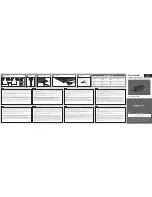
¡
Video Memory
¡
Panel Type
¡
Native Resolution
¡
Audio Controller
¡
Wi-Fi Device
¡
Cellular Device
¡
Bluetooth Device
¡
Wireless USB Device
Battery
Information
Indicates the primary battery and the media bay battery status. Also displays the type of AC adapter connected to the computer.
Boot
Sequence
The computer attempts to boot from the sequence of devices specified in this list:
l
Diskette drive
l
USB Storage Device
l
CD/DVD/CD-RW Drive.
l
Internal HDD (IRRT)
l
(Secondary HDD name)
l
Onboard NIC
This list specifies the order that the BIOS searches devices when trying to find an operating system to boot. To change the boot order,
select the device to be changed in the list then click the up/down arrows or use the keyboard PgUp/PgDn keys to change the boot order of
the device. The boot devices can also be de-selected from the list using the check boxes.
Date/Time
Displays current date and time settings.
System Configuration
Option
Description
NOTE:
The System Configuration group contains options an settings relater to integrated system devices. (Depending on your computer and
installed devices, the items listed in this section may or may not appear.)
SATA Operation
This option configures the operating mode of the internal SATA hard drive controller. The settings are
Disabled
,
ATA
,
AHCI
, and
IRRT
.
Default setting:
IRRT
Miscellaneous
Devices
Use the check boxes to enable/disable the following devices:
l
eSATA Ports
l
External USB Port
l
Microphone
Default setting:
All enabled
.
Latitude ON
Use the check boxes to enable/disable the following devices:
Enable Latitude ON
= Latitude ON is available by pressing the Latitude ON button.
Use instant on mode
= Latitude ON will be instantly available by pressing the Latitude ON button when the computer is off or hibernated.
Instant on mode will use a small amount of battery power to ensure availability of Latitude ON. Without Instant on mode, Latitude ON will
take up to a minute longer to boot, but will not use any battery power when off.
Keyboard
Illumination
This field lets you choose the operating mode of the keyboard illumination feature. The settings are
Disabled
,
Auto ALS and Input
, and
Auto Input Only
.
Default setting:
Auto ALS and Input
USB PowerShare
This option configures the USB PowerShare feature behavior. Use the check box to enable / disable the feature (default state is disabled).
The settings are
0%
,
3%
,
10%
,
25%
,
50%
, and
75%
.
USB PowerShare
Mode
Select either Mode A or Mode B.
Uses Mode A by default. If your device fails to charge with Mode A, please try Mode B.
Video
Option
Description
Ambient Light
Sensor
Enabling ALS will allow your system to automatically change the brightness of your system's LCD panel based on the amount of light in
the environment.
Default setting:
Disabled
LCD Brightness
This option (represented by a slider bar for
On Battery
and
On AC
) sets the panel brightness when the ambient light sensor is off.
Security
Option
Description
Admin Password
This field lets you set, change, or delete the administrator (admin) password (sometimes called the "setup" password). The admin
password enables several security features when set including:
l
Restricts changes to the settings in Setup
l
Restricts the boot devices listed in the <F12> Boot Menu to those enabled in the "Boot Sequence" field.
l
Prohibits changes to the owner and asset tags.
l
Substitutes for the system password if the system prompts for a password during power on.
Successful changes to this password take effect immediately.
NOTE
: If you delete the admin password, the system password is also deleted. Also, the admin password can be used to delete the
HDD password. For this reason, you cannot set an admin password if a system password or HDD is already set. The admin password
must be set first if used in conjunction with a system and/or HDD password.
Summary of Contents for Latitude Z
Page 6: ...Back to Contents Page ...
Page 28: ...Back to Contents Page ...




































